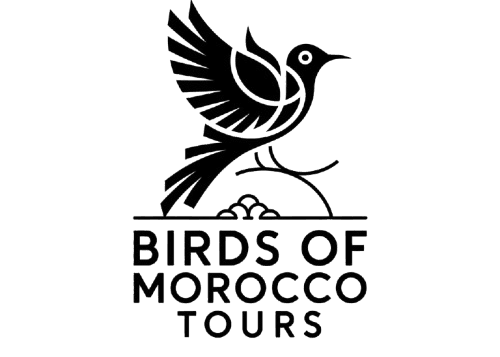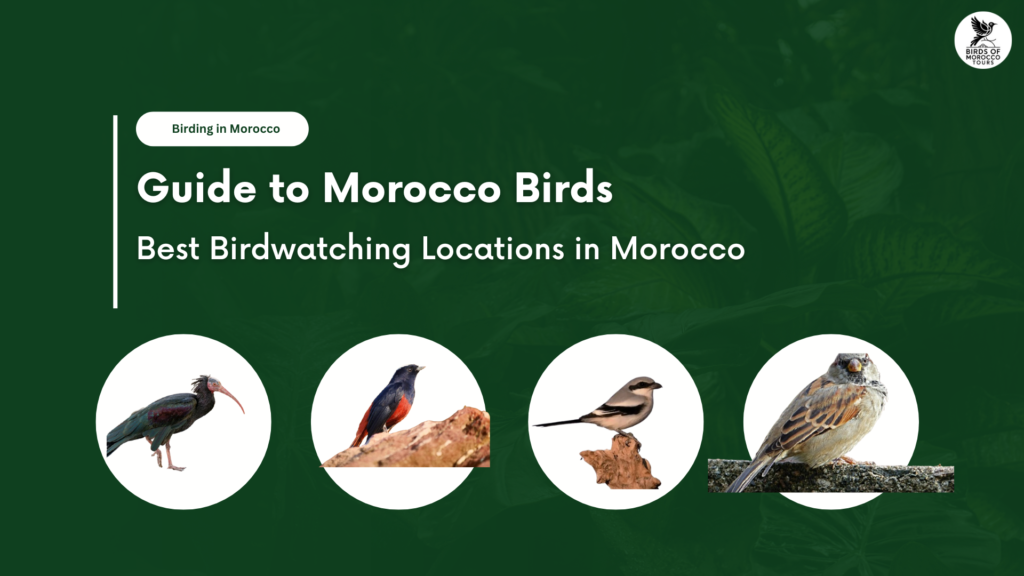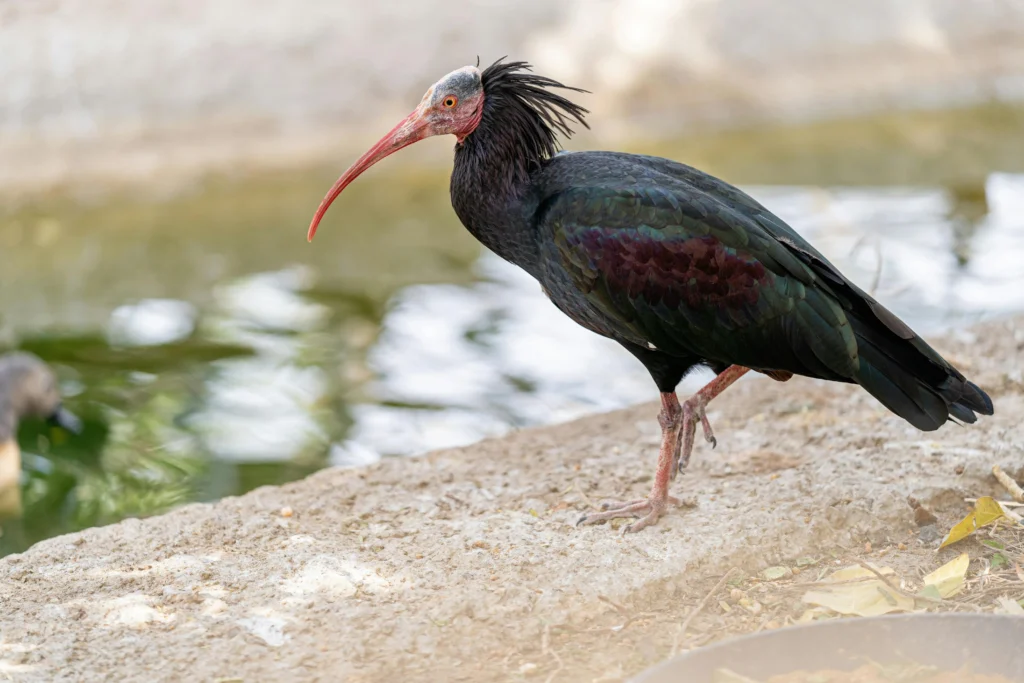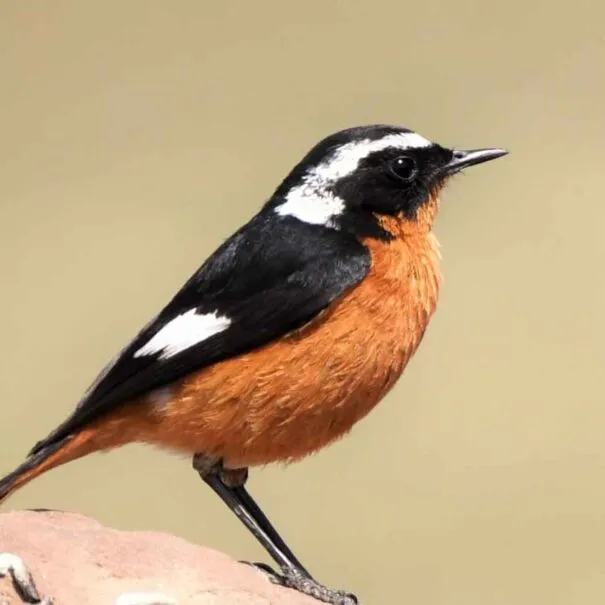Morocco stands as one of North Africa’s premier birdwatching destinations, offering an extraordinary diversity of habitats and species that attract ornithologists and casual birders alike. From the rugged Atlas Mountains to the sprawling Sahara Desert and pristine coastal wetlands, Morocco’s varied landscapes provide sanctuary to over 450 bird species, making it a true paradise for bird enthusiasts.
Birding in Morocco (Guide to Morocco Birds)
Morocco’s strategic location at the crossroads of Europe and Africa creates a unique melting pot of avian biodiversity. This geographical advantage positions the country as a crucial stopover on major migration routes, offering birdwatchers the opportunity to observe both European and African species, as well as endemic birds found nowhere else.
Whether you’re a seasoned ornithologist or a novice with binoculars, Morocco offers something for everyone. The country’s diverse ecosystems support a remarkable variety of resident and migratory birds throughout the year, making it possible to spot everything from majestic eagles to delicate warblers.
Best Times for Bird Watching in Morocco
Planning your birding expedition requires understanding Morocco’s seasonal patterns and how they affect bird populations:
Spring (March-May)
Spring represents the prime birdwatching season in Morocco, coinciding with the northward migration when millions of birds cross the Mediterranean from Africa. During this period, you can witness:
- Spectacular raptor migrations across the Strait of Gibraltar
- European songbirds in brilliant breeding plumage
- Resident species engaged in courtship displays and nesting activities
- Peak activity in wetland areas with numerous wading birds
Autumn (September-November)
Autumn brings the southward migration, offering another excellent opportunity for birdwatching:
- Large flocks heading south toward winter grounds
- Different migration routes compared to spring
- First winter visitors arriving from Europe
- Less crowded conditions at popular birding sites
Winter (December-February)
Winter presents unique opportunities for seeing:
- Wintering water birds in coastal wetlands
- European species escaping harsher northern winters
- Desert specialists more active in cooler temperatures
- Greater visibility in forest areas due to reduced foliage
Summer (June-August)
While summer is generally hotter and drier, it offers advantages for certain interests:
- Resident breeding birds caring for young
- Less competition from migratory species
- Desert birds concentrated around water sources
- Opportunity to observe post-breeding dispersal
Best Birdwatching Locations in Morocco
Morocco’s geographical diversity has created numerous world-class birding habitats, each supporting unique avian communities:
Coastal Birding Spots
Merja Zerga National Park This remarkable coastal lagoon near Moulay Bousselham represents one of Morocco’s premier wetland habitats. The protected area serves as winter home to thousands of waterfowl and waders, including the critically endangered slender-billed curlew. The extensive salt marshes, mudflats, and shallow waters create ideal feeding grounds for flamingos, spoonbills, and numerous duck species.
Tamri Estuary Famous as one of the last strongholds of the critically endangered northern bald ibis, this coastal site offers excellent opportunities to observe these peculiar birds alongside coastal species like Audouin’s gull, Sandwich tern, and various shorebirds. The combination of estuary, cliffs, and scrubland creates diverse microhabitats supporting a wide range of birds.
Mountain Birding Spots
High Atlas Mountains The majestic High Atlas range harbors specialties like Levaillant’s green woodpecker, Moussier’s redstart, and Atlas crimson-winged finch. Higher elevations provide opportunities to spot golden eagles, Bonelli’s eagles, and various alpine species. The juniper and cedar forests offer excellent habitat for numerous woodland birds.
Middle Atlas Mountains The Middle Atlas cedar forests represent crucial habitat for the endangered Barbary macaque and host rich bird communities including Atlas flycatcher, short-toed treecreeper, and coal tit. The diverse landscape of forests, lakes, and rocky outcrops supports varied species assemblages in relatively accessible terrain.
Desert Birding Spots
Merzouga and Erg Chebbi The spectacular dunes of Erg Chebbi create a dramatic backdrop for desert birding. Target species include desert sparrow, Egyptian nightjar, cream-colored courser, and various desert larks. The nearby seasonal lake of Dayet Srji attracts flamingos and numerous waterbirds when filled, creating a remarkable contrast with the surrounding desert.
Tagdilt Track This famous desert birding location near Boumalne Dades offers excellent opportunities to observe specialized desert birds including various larks (Temminck’s, hoopoe, thick-billed), desert wheatear, red-rumped wheatear, and cream-colored coursers. The stony desert (hammada) habitat supports unique assemblages of birds adapted to extreme conditions.
Wetland Birding Spots
Souss-Massa National Park This coastal national park south of Agadir protects crucial habitat for the northern bald ibis while offering excellent birdwatching in diverse habitats. The river mouth, wetlands, scrub, and agricultural areas support marbled teal, glossy ibis, little swift, and numerous passerines. The park’s varied landscapes make it possible to observe over 100 species in a single day.
Oualidia Lagoon This picturesque coastal lagoon provides important habitat for migrating and wintering waterbirds. The protected waters support grebes, herons, egrets, and numerous duck species. The surrounding salt pans attract waders and shorebirds, while nearby scrubland hosts various passerines and raptors.
Moroccan Bird Species Guide
Morocco hosts an impressive diversity of bird species, including many that are difficult or impossible to see in Europe. Here’s an introduction to some of the most sought-after species:
Northern Bald Ibis (Geronticus eremita)
- Conservation Status: Critically Endangered
- Where to Find It: Coastal cliffs near Tamri and Souss-Massa National Park
- Description: Distinctive black plumage with bare red face and head, downward-curved bill
- Significance: One of the world’s rarest birds, with Morocco hosting most of the remaining wild population
Moussier’s Redstart (Phoenicurus moussieri)
- Conservation Status: Least Concern
- Where to Find It: Atlas Mountains, coastal scrub, and forest edges
- Description: Male has striking orange-red underparts, black face and back with prominent white wingbar
- Significance: Endemic to northwest Africa and a priority target for visiting birdwatchers
Levaillant’s Woodpecker (Picus vaillantii)
- Conservation Status: Least Concern
- Where to Find It: Middle and High Atlas forests
- Description: Similar to European green woodpecker but with distinctive black cheeks and smaller size
- Significance: Near-endemic to northwest Africa, found primarily in Morocco and Algeria
Desert Sparrow (Passer simplex)
- Conservation Status: Near Threatened
- Where to Find It: Sandy deserts around Merzouga and Erg Chebbi
- Description: Male has pale sandy-gray plumage with black bib and facial mask; female uniformly pale
- Significance: Declining specialist of remote desert regions
Conservation Efforts and Responsible Birding
Morocco faces significant conservation challenges, including habitat loss, climate change, and development pressures. Several organizations, including GREPOM/BirdLife Morocco, are working to protect the country’s avian biodiversity. As responsible birdwatchers, we can contribute by:
- Supporting local conservation initiatives through donations or volunteer work
- Following ethical birdwatching practices by maintaining appropriate distances and minimizing disturbance
- Contributing to citizen science by submitting observations to platforms like eBird
- Hiring local guides who understand sustainable practices and support local economies
- Raising awareness about Morocco’s unique bird heritage and conservation needs
Practical Tips for Birding in Morocco
To make the most of your birdwatching experience in Morocco:
- Bring proper equipment: Quality binoculars (8×42 recommended), spotting scope for wetland watching, appropriate field guides, and photography gear if desired
- Hire a local guide: Their knowledge of bird locations, language skills, and cultural understanding will greatly enhance your experience
- Plan according to seasons: Each season offers different birding opportunities
- Respect local customs: Morocco is a conservative country; dress modestly and ask permission before photographing people
- Learn basic phrases: A few words in Arabic or French go a long way in rural areas
- Stay hydrated: Especially important in desert environments
Conclusion of The Guide to Morocco Birds
Morocco offers exceptional birdwatching opportunities throughout the year, with its diverse landscapes supporting remarkable avian diversity. From the critically endangered northern bald ibis to desert specialists and Mediterranean endemics, the country provides unforgettable encounters with unique and beautiful birds. Whether you’re planning your first African birding trip or returning to explore new areas, Morocco’s rich ornithological treasures await discovery.
By planning your visit to coincide with optimal seasons and visiting the country’s birding hotspots, you’ll maximize your chances of memorable sightings while contributing to conservation efforts that protect these precious resources for future generations. The combination of spectacular landscapes, rich culture, and extraordinary birdlife makes Morocco a must-visit destination for any serious birdwatcher.



